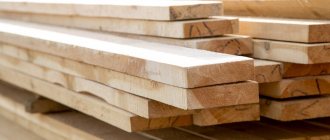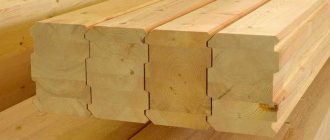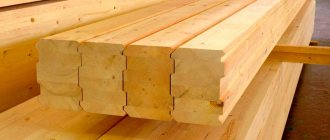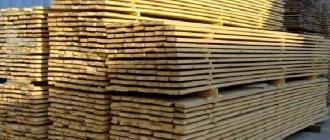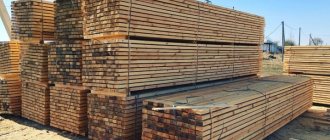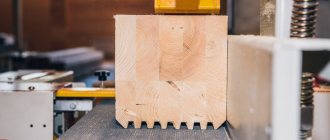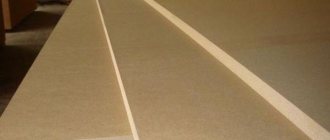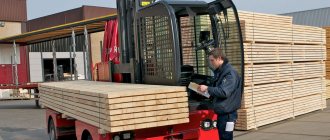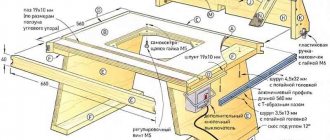In preparation for the construction of a frame house, erecting a roof and assembling the crowns of a log house, the developer has to purchase timber. This material is used for the manufacture of various wooden structures, so its range includes dozens of items. To eliminate errors, you need to determine as accurately as possible how much timber is in a cubic meter.
The “mathematical model” of this operation is simple. To calculate the volume of any rectangular object, its length is multiplied by its width and height. However, in practice, when purchasing a large number of timber of different lengths and sections, you can get confused and overpay a considerable amount.
In this article we will talk about the important nuances of calculating the volume of lumber and provide easy-to-use “cheat sheets” for converting linear meters of timber into cubes.
Why do you need to know how much timber is in a cube?
First, let's figure out what is considered a timber. Lumber with a rectangular cross-section, width and length of at least 100 mm, is called timber. Anything smaller is called a block. That is, 100*100 and 100*125 are timber, 100*75, 100*50 are timber. These are specifics of terminology, but it’s worth knowing this so as not to get confused in the assortment.
Standard sizes
Why know how many pieces of timber are in one cube? For example, for construction, 45 pieces with a size of 150*150 and 23 pieces with a size of 100*100 are required. How many cubes will you order? You need to look for a table for converting cubes into pieces (also called lumber cubes), or calculate it yourself.
Tables for quickly calculating the volume of timber
Below are cheat sheets to quickly find out how much timber is in a cube - the table contains not only the quantitative values of units of material per cubic meter, but also the volumetric values of timber of different sections. For example, the table will show how many boards are in a cube - 6 meters or 3 meters long will a board or timber be.
How much timber is 3 meters long in a cubic meter?
| Height, width and length of timber, mm | How many pieces in a cubic meter | Volume of one piece, m³ |
| 50x50x3000 | 133,33 | 0,0075 |
| 50x100x3000 | 66,67 | 0,015 |
| 60x60x3000 | 92,6 | 0,0108 |
| 60x100x3000 | 55,55 | 0,018 |
| 75x75x3000 | 59,26 | 0,0169 |
| 75x100x3000 | 44,44 | 0,0225 |
| 100x100x3000 | 33,33 | 0,03 |
How much timber is 6 meters long in a cubic meter?
| Height, width and length of timber, mm | How many pieces in a cubic meter | Volume of one piece, m³ |
| 50x50x6000 | 66,67 | 0,015 |
| 50x100x6000 | 33,33 | 0,03 |
| 60x60x6000 | 46,3 | 0,0216 |
| 60x100x6000 | 27,78 | 0,036 |
| 75x75x6000 | 29,63 | 0,03375 |
| 75x100x6000 | 22,22 | 0,045 |
| 75x150x6000 | 14,8 | 0,0675 |
| 100x100x6000 | 16,67 | 0,06 |
| 100x150x6000 | 11,11 | 0,09 |
| 100x200x6000 | 8,33 | 0,12 |
| 100x250x6000 | 6,67 | 0,15 |
| 125x125x6000 | 10,67 | 0,09375 |
| 150x150x6000 | 7,41 | 0,135 |
| 200x200x6000 | 4,17 | 0,24 |
| 200x250x6000 | 3,33 | 0,3 |
| 250x250x6000 | 2,67 | 0,375 |
If you need to find, for example, how many 100x100 lumber are in a cube, then in the table we look for a board of the required size and see the result - at least 16.67 pieces, and the volume of one lumber 6 meters long is 0.06 m³.
See also: Catalog of companies that specialize in the design and construction of country houses made of turnkey timber.
How many boards are 2 meters long in a cubic meter?
| Height, width and length of the board, mm | How many pieces in a cubic meter | How many linear meters in one cubic meter | Volume of one board, m³ | Area of one board, m² |
| 25x100x2000 | 200 | 400 | 0,005 | 0,2 |
| 25x150x2000 | 133,3 | 266,7 | 0,0075 | 0,3 |
How many boards per cubic meter are 3 meters long?
| Height, width and length of the board, mm | How many pieces in a cubic meter | How many linear meters in one cubic meter | Volume of one board, m³ | Area of one board, m² |
| 20x100x3000 | 167,6 | 500 | 0,006 | 0,3 |
| 20x150x3000 | 111,1 | 333,3 | 0,009 | 0,45 |
| 22x100x3000 | 151,5 | 454,5 | 0,0066 | 0,3 |
| 22x125x3000 | 121,2 | 363,6 | 0,00825 | 0,0375 |
| 22x150x3000 | 101 | 303 | 0,0099 | 0,045 |
| 22x175x3000 | 86,6 | 259,7 | 0,01155 | 0,525 |
| 22x200x3000 | 75,8 | 227,3 | 0,0132 | 0,6 |
| 22x225x3000 | 37,3 | 202 | 0,01485 | 0,675 |
| 22x250x3000 | 60,6 | 181,8 | 0,0165 | 0,75 |
| 25x100x3000 | 133,3 | 400 | 0,0075 | 0,3 |
| 25x125x3000 | 106,7 | 320 | 0,009375 | 0,0375 |
| 25x150x3000 | 88,9 | 266,7 | 0,01125 | 0,45 |
| 25x175x3000 | 76,2 | 228,6 | 0,012125 | 0,525 |
| 25x200x3000 | 66,7 | 200 | 0,015 | 0,6 |
| 25x225x3000 | 59,3 | 177,8 | 0,016875 | 0,675 |
| 25x250x3000 | 53,3 | 160 | 0,01875 | 0,75 |
| 32x100x3000 | 104,2 | 312,5 | 0,0096 | 0,3 |
| 32x125x3000 | 83,3 | 250 | 0,012 | 0,0375 |
| 32x150x3000 | 69,4 | 208,3 | 0,0144 | 0,45 |
| 32x175x3000 | 59,5 | 178,6 | 0,0168 | 0,525 |
| 32x200x3000 | 52,1 | 156,3 | 0,0192 | 0,6 |
| 32x225x3000 | 46,3 | 138,9 | 0,0216 | 0,675 |
| 32x250x3000 | 41,7 | 125 | 0,024 | 0,75 |
| 40x100x3000 | 83,3 | 250 | 0,012 | 0,3 |
| 40x125x3000 | 66,7 | 200 | 0,015 | 0,0375 |
| 40x150x3000 | 55,6 | 166,7 | 0,018 | 0,45 |
| 40x175x3000 | 47,6 | 142,9 | 0,021 | 0,525 |
| 40x200x3000 | 41,7 | 125 | 0,024 | 0,6 |
| 40x225x3000 | 37 | 111,1 | 0,027 | 0,675 |
| 40x250x3000 | 33,3 | 100 | 0,03 | 0,75 |
| 50x100x3000 | 66,7 | 200 | 0,015 | 0,3 |
| 50x125x3000 | 53,3 | 160 | 0,01875 | 0,0375 |
| 50x150x3000 | 44,4 | 133,3 | 0,0225 | 0,45 |
| 50x175x3000 | 38,1 | 114,3 | 0,02625 | 0,525 |
| 50x200x3000 | 33,3 | 100 | 0,03 | 0,6 |
| 50x225x3000 | 29,6 | 88,9 | 0,03375 | 0,675 |
| 50x250x3000 | 26,7 | 80 | 0,0375 | 0,75 |
| 60x125x3000 | 44,4 | 133,3 | 0,0225 | 0,0375 |
| 60x150x3000 | 37 | 111,1 | 0,027 | 0,45 |
| 60x250x3000 | 22,2 | 66,7 | 0,045 | 0,75 |
| 75x175x3000 | 25,4 | 76,2 | 0,0394 | 0,525 |
| 75x200x3000 | 22,2 | 66,7 | 0,045 | 0,6 |
| 75x225x3000 | 19,7 | 59,3 | 0,051 | 0,675 |
Calculation from tabular data
The option with a table is simpler - count less, but keep in mind that the table shows a standard length of 6 meters. If you need such material, no problem. In this case, look at how much timber of this size goes into 1 m³, divide the amount you need by this number and get the number of cubes. The number is usually a fraction, so round to the nearest higher whole number. When the fractional part is small, you can try ordering 2.5 m³ or 3.5 m³. Some suppliers do this.
Table of the amount of timber in one cube
To make it clearer, let's look at the calculation using an example. As already mentioned, 45 pieces will be needed. timber 150*150 and 23 pcs. "hundreds". From the table we see that there are 16 pieces of 100*100 in one cubic meter. We need 23. So 23/16 = 1.4375 cubic meters and it might be better to order 1.5 cubic meters. After all, it’s better to have a supply than to later buy additional material and incur new costs for delivery. If there are leftovers, they will be useful for some other purpose.
When talking about lumber, most often the dimensions are indicated in millimeters: 200x200, 100x150, etc. But sometimes the size is given in centimeters: 20x20; 15x20, etc.
Let's calculate how many cubes of 150*150 mm timber we need. According to the table, one cube of timber of this size contains 7 pieces. We count: 45/7 = 6.428 m³. We round up and it turns out that we will need 7 cubes of lumber of this size.
Calculation of lumber for construction before purchasing it
How to calculate the cost of upcoming construction? How much do the walls weigh and how strong a foundation is needed for future construction? All this can be calculated at the stage of choosing the size of a house or wooden bathhouse.
Of course, the easiest way is to come to the developer to explain what you want to see in the final version and agree to the proposed project. But, if you independently understand the calculations of the required amount of lumber, then even at the stage of discussing the cost of materials and work on building a house, you can get an idea of how realistic the prices are offered by the construction company.
Many developers calculate the required amount of material in cubes, some count individually, taking the standard length dimensions as 6 or 12 m. A clear understanding, for example, of how much timber is in a 150x150x6000 cube will protect you from overpayments.
Standard timber 0.15x0.015x6 meters Source wtnasos.ru
How to calculate it yourself
If you have tabular data, the calculation is quite simple. But the table does not always help. This only works if you require standard length material. Often you have to cut timber - to grow it to the required length or for small walls. Buying a standard for cutting is expensive. Lumber of shorter lengths costs much less. It is considered a re-grade and is cheaper. How to calculate correctly in this case? It's not that complicated, elementary school math.
We count how many cubes are in the timber ourselves. Calculation formula.
To calculate, you will need to know the volume of each unit. The material is a highly elongated parallelepiped, which means a volume formula is needed. You need to multiply all the dimensions - length, width and thickness.
For example, let’s calculate the volume of timber 150*200*4000. All data is given in millimeters. But we need cubic meters, and for this we will convert millimeters into meters, that is, divide the result by 1000. So, we get: 0.15 * 0.2 *4. These are the same dimensions, only in meters. Now we multiply everything: 0.15 · 0.2 · 4 = 0.12 m³. It turned out that one beam of a given size has a volume of 0.12 cubic meters. Calculating how much timber of this size will be in one cube is simple: divide 1 by the resulting volume. 1/0.12 = 8.33 pcs. That is, 8 pieces will be shipped to you.
How much lumber is in a cube?
You can also count how many pieces of planks or boards, and any rectangular lumber, are in a cube. Just remember that all dimensions must be in meters. Then you will get the correct result. To check, we provide a table of the quantities in one cube of boards (tongue and edged) of different sizes.
What is a cubic meter
A cubic meter (abbreviated m³) is a unit of volume and is equal to the volume of a cube with an edge length of 1 meter. In accordance with GOST 8486-86, wooden materials must have measurable cross-sectional dimensions and lengths, so that the number of boards included in a cube of material can be easily calculated.
To determine the dimensions of the section, it is necessary to step back from the end of the beam at a distance of at least 10 cm and measure the width and height of the beam. By multiplying these values by each other, you get the cross-sectional area of the beam, multiplying it by the length to get the volume of one beam. By calculating the number of beams in one cubic meter, you can easily navigate between the cost of one beam and one cube of beams.
A cubic meter is equal to the volume of a cube with an edge side of 1 m Source wtnasos.ru
Calculation of materials for construction
If the timber goes to supports, rafter system , it is easier to count the number of pieces. But how to calculate how much it is needed for a house, without counting the number of crowns? You can, of course, do this, but it’s easy to make a mistake. How can you find out how much material you need for your home? Decide immediately on the cubic capacity.
Example . House 12*10, height to the top crown 2.8 meters. We will build with timber 200x200x6000. We don't need to know the quantity. Let's calculate how many cubes will go on the outer walls.
You can calculate the amount of material for your home yourself
The calculation procedure is as follows:
- We calculate the perimeter of the house. In plan, the house looks like a rectangle, so (12+10)*2 = 44 meters.
- Now we multiply the perimeter by the width of the wall (in this example it is 200 mm or 0.2 meters) and by the height of the walls - 2.8 meters. We get: 44 * 0.2 * 2.8 = 24.64 m³.
- Rounding up, we found that to build external walls we will need 25 cubes of timber 200 mm wide.
- If you need to determine exactly how many pieces you will get, you need to divide the total volume of 24.64 m³ by the volume of 1 piece. From here we get 24.64 m³/0.24 m³=102.66.
The height of the house can be any, here you decide for yourself. There is a difference in the price of the material, because larger timber costs more. You need to recalculate if you decide to change the width of the wall and make, say, 250 mm. In this case, instead of 0.2 we substitute 0.25. 44*0.25*2.8 = 30.8 m³. That is, you will need 6 cubic meters more timber. This is logical, since the quantity of timber 250x250 will be less in a cube, and the volume will be greater than 200x200.
Approximate difference in price of 150x150 timber in different regions
The cost of timber depends on the region of the country, type of wood, moisture content of the material, delivery method and many other factors. For comparison, data for timber 150x150x6000 was taken. The type of material is pine. The cost of one cube is presented in the table.
Table. The cost of 1 cube of timber is 150x150x6000 (pine) depending on the region.
| Price, rub/m³ | 8500 | 8151 | 6825 | 6800 | 8100 |
| Region | Ekaterinburg | Permian | Chelyabinsk | Krasnoyarsk | Novosibirsk |
How much does a cube of timber weigh?
Why know the weight of m3 of timber? So as not to miss the delivery. If you pay for the delivery and order it, you will need to take into account the weight in addition to the cubic capacity. And, of course, the weight of the structure is required when calculating the foundation.
The weight of any lumber depends not only on size, but also on humidity and the type of wood. You can't determine it yourself. So you have to rely only on tables.
| Wood species | Weight 1 cubic meter wood in kg at different humidity | |||
| Dry, 10-18% | Air dry, 19-23% | Raw, 24-45% | Freshly cut and wet, >45% | |
| Linden, cedar, poplar, spruce, fir | 450 | 500 | 550 | 800 |
| Alder, pine, aspen, willow | 500 | 550 | 600 | 800 |
| Birch, elm, chestnut, larch, elm | 600 | 650 | 700 | 900 |
| Acacia, beech, hornbeam, oak, ash | 700 | 750 | 800 | 1000 |
The volumetric weight table shows the weight (in kilograms) of one cubic meter of lumber for different types of wood, at different humidity levels. To find out how much your order will weigh, select the type and moisture content of the ordered material. Find the number at the intersection. You multiply it by the number of cubes.
Example . We will order 25 cubic meters of air-dried pine timber. One cube of pine in this condition weighs 550 kg. Weight of 25 cubic meters: 550 * 25 = 13,750 kg. Approximate weight will be 14 tons. This task can be handled, for example, by an onboard KAMAZ 65117 with an awning or a Volvo F10, etc.
What else to consider when counting lumber
One of the nuances in the production of lumber is their technological length, that is, the declared six-meter board in practice turns out to be 5-10 cm longer. This deviation is called technological and is not taken into account when calculating the linear meters of the board. The seller under no circumstances has the right to add them to the total length of the board.
When purchasing timber of a certain cross-section, it is important to measure the parameters upon acceptance or loading, since the slightest deviation of even 1 cm leads to huge losses, especially with large purchase volumes.
In addition to volume, it is important to remember the weight of the purchased material, which depends on the density of the material and humidity.
An example of calculating the weight of a beam based on the known density of wood (for materials of different moisture content, you need to substitute the corresponding values instead of 860) Source kamtehnopark.ru
Laying timber
There are a lot of ways to lay timber on a finished foundation, but the work is carried out according to one principle and is carried out in several stages:
- Installation of the crown molding;
- Installation of building walls;
- Laying the rafter system.
The first stage is the creation of a frame (covering crown), that is, the first layer of timber on the foundation. The surface must first be covered with a layer of heat and waterproofing. First, parallel beams are laid, then other logs are mounted in the corresponding grooves. For the crown, it is recommended to use coniferous wood, such as pine or larch, as they are the most resistant to moisture.
Then the walls are installed by laying rows of timber on top of each other. They are also recommended to be laid with layers of thermal insulation. There are a large number of options for fastening logs together - you can use ordinary nails, wooden fasteners, or make recesses in the bars in advance to align them.
After the crown and walls shrink, the installation of the rafter system for the roof begins. It is an important structural element, as it ensures the stability of the walls and relieves some of the load from them. The type and method of laying rafters should be selected in accordance with the chosen roofing option.
The process of counting and building houses made of timber always seems very complicated from the outside. However, using the simple formulas listed in our article, even an inexperienced builder can solve the problem of purchasing material.
Some nuances in the calculations
- If the material has grooves, tenons and the like, such as on a floor slats or lining, the calculation is carried out only on the working surface. No fasteners are taken into account in the material calculation.
- It is important to monitor the seller’s calculations, namely how he rounds. The so-called rounding in mathematics occurs as follows: all tenths up to five are rounded down, 5 tenths are left, all tenths over five are rounded up.
- It is best to have a calculation table on hand. It will protect you from deception or simple ignorance on the part of the seller.
Working with ready-made cubic capacity calculations
Of course, not all standard sizes are given here, but as an example it can be seen that the cubic capacity of various logs was calculated with great accuracy. In practice, the thickness (diameter) is measured, as indicated in GOST, then the length and the cubic capacity are found from the table. Since the cut circle of the log is not ideal in shape, 2 diameter measurements are taken perpendicularly and its average value is found. It is this value that you need to look for in the line.
Figure 2. Using a measuring fork, you can measure the diameter and calculate the cubic capacity of a tree.
Example. A 6-meter log in the upper cut has 2 diameter sizes (30 and 34 cm excluding bark), measured perpendicularly. We find the average value of the cut diameter is 32 cm. The length of the log is 6 m. From the table we find that at the intersection of the row with the value of 32 cm and the column of 6 m there is a volume value of 0.59 m³. If the log is rounded, then just one diameter measurement is enough. The error of the results is 2-4%, which is acceptable for most practical calculations.
When harvesting timber for a home, each log can be measured, but there is not always enough time and effort for this. Here they use an industrial method for calculating cubic capacity. The timber is sorted by length and then by equal top diameters. Measurements are made in each group of one product.
And only after stacking in stacks or in a machine, the quantity is counted and the total cubic capacity is calculated by simply multiplying the number of logs by the volume of one of them.
Scheme for determining the diameter of the upper end.
In the forestry industry, for taxation (determining the stock of standing timber), in addition to simple tools, there are special electronic devices for measuring and calculating the parameters of standing trees.
Masser 2000 is a computerized measuring fork that allows you not only to accurately measure the reference diameter of a standing tree at a height of 1.3 m, but also to immediately determine the cubic capacity taking into account the type, height and crown of the tree. The device then outputs all collected information to the computer (Fig. 2).
What is timber and what you should know about it
A timber is a material made of wood, processed on two or more sides, the cross-section of the material is square or rectangular.
The minimum cross-sectional size is 100X100 mm; if the cross-section is smaller than these parameters, then such material is usually called a board. The most common section sizes: 150X150, 200X200 mm.
The length of the timber can vary from 3 to 12 m. Most often, this type of lumber is made from softwood, pine, spruce, cedar, larch. Pine is most often used.
There are several reasons for this:
- This type of wood is distributed over most of the land.
- Quite low price.
- Has a straight trunk with a minimum number of knots
- Easy to process.
Coniferous trees, in particular pine, have a very high heat conductivity coefficient, it is 0.1-0.3 units. Therefore, walls in houses made of such material retain heat longer. The resin content of conifers has a beneficial effect on durability.
It is important that when working with wood the material is dry. If the finished material contains 10%-12% moisture, this is simply wonderful.
Calculation using an online calculator
If you don’t have a table at hand, and doing independent calculations is difficult, you can use free online calculators; there are a great many of them on the web.
It is important to choose a calculator that calculates building materials, preferably in those metric indicators with which it is customary to work in a given area. Such a calculator will be able to calculate the amount of laminated veneer lumber and profiled timber.
All calculations are carried out automatically. The user is required to correctly indicate the type of lumber.
Calculation for bars of a different size
If you need to purchase timber of standard sizes, you don’t have to calculate it using formulas and use a special table. It indicates the parameters of the material (width, height and length), the volume of one piece and the number of pieces per 1 m3.
If you need to purchase timber of non-standard dimensions, the same formulas are used for it as for the regular dimensional grid. Please note that the calculation is made in tens of meters, so this way you can easily find out the volume of any material.
Features of lumber storage
To build a house made of wood, it is important to properly store the material so that its humidity is within 12%; if the humidity is higher, the shrinkage of the building will be slower.
Here are a few rules to remember when storing lumber:
- The storage area must be level and dry.
- To prevent moisture from entering the site onto the site, pallets are placed under the first layer of material, which can be replaced with scraps of boards or sleepers.
- The distance between individual products should be maintained at least 2 cm for better air circulation.
- After 1-2 rows, crossbars are placed across the length, which can be the same cuttings of boards.
- If it is not possible to erect a canopy over the storage area to prevent precipitation from entering, the stacks are covered with film, excluding wrapping the ends, so as not to create a greenhouse effect inside.
Wood stacked for storage Source woodguide.ru
